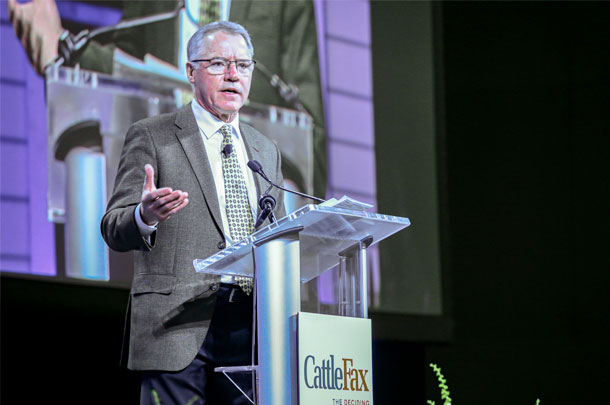Progressive Cattle Editor David Cooper Published on 17 February 2020
Seeing a younger audience of cattle producers before him at the National Cattlemen’s Beef Association convention in San Antonio, Randy Blach offered a brief history lesson on today’s industry versus that of the 1980s.
The CattleFax CEO outlined how far the beef industry declined from 1980 to 1998, with cattle numbers plunging 20 million head, and 403,000 producers getting out of the business, Blach said.
“The diet health scare and the war on fat, as we came through that, it was devastating. We know most of that information wasn’t accurate, but we couldn’t defend ourselves.”
Blach then issued a warning: “I challenge you, if we don’t handle this sustainability message, this is what we could be dealing with again. I believe this is our greatest risk as an industry.”
“The U.S.,” he said, “has the most environmentally efficient beef production system in the world, but we’re always on the defensive.”
Cattle markets today reflect that efficiency going into 2020. Whereas the industry had a $32 per head profitability margin that was split among four segments back in 1980, today that number is around $500 per head.
“When we look at 2020, all segments will be profitable. How many times do we get an opportunity to say that? That all industry segments will be profitable.”
The trend is boosted by four consecutive years of profitability for packers, Blach said. Slaughtered fed cattle went from 30 million head in 2000 and then dropped over 15 years through contraction and drought. “By the time we got to 2015, we were harvesting 23 million. Is it any wonder we lost a few of these packing plants?”
“I won’t be surprised to see some packers come back online, or some expansion of existing plants to work through this bottleneck. We’re going to have difficulty growing the herd, with the situation we have with shackle space, not only on fed cattle side but non-fed side.”
Blach said the industry owes much of its profitability increases to export growth and value incentive programs that reward producers raising quality beef.
New trade deals with the emerging Chinese market, and the foundational strength of the Japanese market, will pay off this year.
The value of meat exports grew from $3.6 billion in 2000 and then fell to BSE and jumped back to $4.1 billion in 2010. Then the market started soaring with $8.2 billion for beef exports in 2019. CattleFax has forecasted export beef values jumping to $11.3 billion by 2025. That will require good water and grass, and further investments in the quality programs, Blach said.
“I think we’re going through a major transformation in this industry. We’re moving away from the boom-and-bust market to a demand-driven market.”
While the industry focuses on yield and quality, Blach said, it should invest further in more processes the consumer is going to want.
“I think there is going to be value associated with being able to tell the story of the animal care, the history, traceability, the source-verified (beef), that’s going to be a checkmark on a lot of the value systems going forward.
“I know some of you aren’t wanting to hear this, but this is what our consumers want from us. I think we’ll be able to respond to this as we go forward.”
Blach also said the beef industry must continue using its data and grid pricing systems effectively, while providing more industry solutions on price discovery.
“This is something we’re going to have to address in the next few years: We do need to have a viable cash market in order to establish credible price discovery on daily and weekly basis.
“Again, in some areas of the country, this is not an issue, when we look in the northern areas especially. But as we get into the Central and Southern Plains, this becomes more of an issue.
It’s not going to go away; I think we’ll find a solution to it as we move forward.”
Blach said the Tyson plant fire in August, and the resulting volatility in prices for cow-calf producers, threw many into a tailspin. But he reiterated what many economists have said on the incident, and praised the markets that adjusted to oversupply and labor demands.
“We incentivized packers with record margins, and there was a lot of short-term pain. But when the plants reopened, we estimated there were less than 75,000 head of cattle backed up in the system. If we had not incentivized, we would have had several hundred thousand head of cattle backed up. The impact would have lasted into a new year.
“I know some of you were hurt as we went through that. But in the long term, the markets did what they needed to do to work us through that situation.” ![]()

-
David Cooper
- Managing Editor
- Progressive Cattle
- Email David Cooper
PHOTO: CattleFax CEO Randy Blach says 2020 will be a good year for the beef industry. Photo by Cassidy Woolsey.








